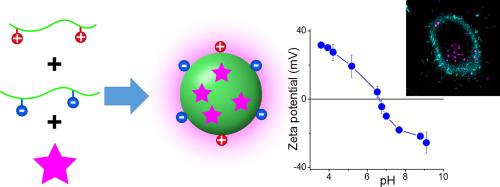Journal of Colloid and Interface Science ( IF 9.4 ) Pub Date : 2021-09-20 , DOI: 10.1016/j.jcis.2021.09.080 Antoine Combes 1 , Khanh-Nam Tang 1 , Andrey S Klymchenko 1 , Andreas Reisch 1

|
Hypothesis
Polymer nanoparticles (NPs) have a very high potential for applications notably in the biomedical field. However, synthetic polymer NPs cannot yet concurrence the functionalities of proteins, their natural counterparts, notably in terms of size, control over internal structure and interactions with biological environments. We hypothesize that kinetic trapping of polymers bearing oppositely charged groups in NPs could bring a new level of control and allow mimicking the surfaces of proteins.
Experiments
Here, the assembly of mixed-charge polymer NPs through nanoprecipitation of mixtures of oppositely charged polymers is studied. Two series of copolymers made of ethyl methacrylate and 1 to 25 mol% of either methacrylic acid or a trimethylammonium bearing methacrylate are synthesized. These carboxylic acid or trimethylammonium bearing polymers are then mixed in different ratios and nanoprecipitated. The influence of the charge fraction, mixing ratio of the polymers, and precipitation conditions on NP size and surface charge is studied.
Findings
Using this approach, NPs of less than 25 nm with tunable surface charge from +40 mV to −40 mV are assembled. The resulting NPs are sensitive to pH and certain NP formulations have an isoelectric point allowing repeated charge reversal. Encapsulation of fluorescent dyes yields very bright fluorescent NPs, whose interactions with cells are studied through fluorescence microscopy. The obtained results show the potential of nanoprecipitation of oppositely charged polymers for the design of NPs with precisely tuned surface properties.
中文翻译:

通过相反电荷聚合物混合物的纳米沉淀产生蛋白质样颗粒
假设
聚合物纳米粒子 (NPs) 具有非常高的应用潜力,尤其是在生物医学领域。然而,合成聚合物纳米粒子还不能同时具备蛋白质、其天然对应物的功能,特别是在大小、对内部结构的控制以及与生物环境的相互作用方面。我们假设 NPs 中带有相反电荷基团的聚合物的动力学捕获可以带来新的控制水平并允许模拟蛋白质表面。
实验
在这里,研究了通过对带相反电荷的聚合物混合物进行纳米沉淀来组装混合电荷聚合物纳米粒子。合成了由甲基丙烯酸乙酯和 1 至 25 mol% 的甲基丙烯酸或含三甲基铵的甲基丙烯酸酯制成的两个系列的共聚物。然后将这些含羧酸或三甲基铵的聚合物以不同的比例混合并进行纳米沉淀。研究了电荷分数、聚合物的混合比和沉淀条件对纳米粒子尺寸和表面电荷的影响。
发现
使用这种方法,组装了小于 25 nm 且表面电荷从 +40 mV 到 -40 mV 可调的 NP。得到的 NPs 对 pH 敏感,并且某些 NP 配方具有允许重复电荷反转的等电点。荧光染料的封装产生非常明亮的荧光 NP,通过荧光显微镜研究其与细胞的相互作用。所获得的结果显示了带相反电荷的聚合物的纳米沉淀用于设计具有精确调谐表面特性的纳米粒子的潜力。











































 京公网安备 11010802027423号
京公网安备 11010802027423号